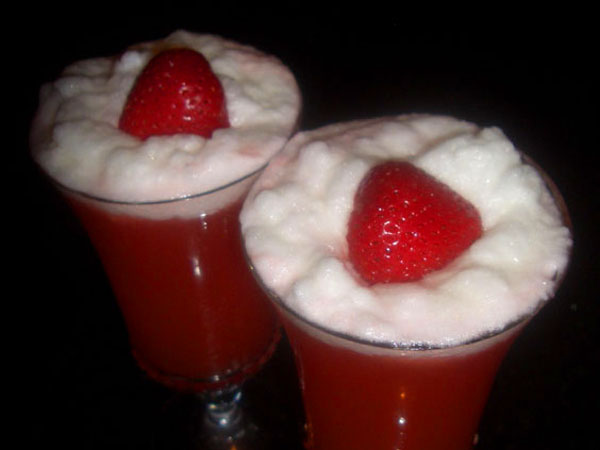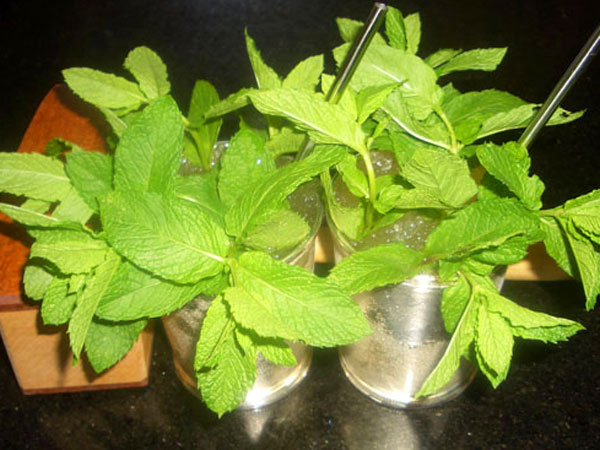 The Strawberry-Lemon Froth, made with not a drop of alcohol!
The Strawberry-Lemon Froth, made with not a drop of alcohol!
At the Boston 19th Century Pub Crawl last month, I got the chance to meet Frederic, one of the esteemed authors of Boston cocktail blog Cocktail Virgin Slut. After chatting over old-timey drinks, I invited him to do a guest post on FPF.  His response: “I have this great temperance book I’ve been meaning to try out!”
Not  the reaction you’d normally expect from a cocktail blogger.  But his article (below) carries a very lovely sentiment:  Sometimes you can’t drink. Sometimes you don’t want to drink. Sometimes, your guests feel the same way.  Why should a non-alcholic drink feel any less special than a cocktail; and more than that, as a good host you should go the extra mile to make your guests feel special.
Read more below.
***
When Prohibition rolled around in 1919, the growing art of American drink making that had gained steam in the mid 19th century came to a screeching halt. Alcohol was banned which did not stop its consumption, but the true craftsmen of the trade either fled the country to pursue their livelihood elsewhere or they changed fields entirely. The quality of alcohol dropped and the drinks made from it were less artful in their design and became more a crafty way to cover over harsh off flavors and stings. Well, it should be said that the growing art in alcoholic drink making in American came to a stop, but those in the Temperance movement seized the opportunity to provide guidance to hosts and hostesses on how to entertain. One of these individuals was Bertha E. L. Stockbridge. Her seminal 1920 book, What to Drink: The Blue Book of Beverages; Recipes and Directions for Making and Serving Non-alcoholic Drinks for all Occasions turned out to be just as valuable and intricate as the liquor-soaked ones of Jerry Thomas and Harry Johnson.
Bertha’s first book, the 1918 treatise The Liberty Cook Book: A Guide to Good Living Combined with Economy, with a Comprehensive Section on Up-to-date Canning, Preserving, Pickling, Jelly Making and Drying, showcased her culinary strengths from making breakfast cereals to cooking organ meats. While the section on non-alcoholic beverages in the book was rather short, her cookbook did provide the basis for her drink book by working out how to make a variety of flavored and fruit syrups that would become the key components in What to Drink. When Prohibition rolled around a year later, she soon saw the necessity to expound on this topic.
Bertha explained, “The hostess of to-day will be called upon to serve drinks in her home more than formerly, I imagine, and it were well to go back to the habits and customs of our grandmothers and be prepared to serve a refreshing drink in an attractive manner at a moment’s notice.†To prepare for guests, Bertha recommended having a stock of homemade or commercial syrups and vinegar-based shrubs ready to create satisfying beverages for guests. Since making these ingredients can be time consuming, Bertha offered up recipes to make all of that labor worth the while. One of the great differences between the alcoholic cocktail and the Temperance drink is that the latter often requires more effort to prepare, and time in the kitchen was almost a necessity. If the hostess is entertaining in a Dry way, Bertha offered advice on how to be popular despite eschewing spirits, and these pointers are reminiscent of Harry Johnson’s tips in his Bartender’s Manual on how to run a bar. On a more spiritual side, the book’s forward presented a parody of the Persian poet Omar Khayyám that read, “A Box of Chocolate underneath a bough,/An Ice Cream Cone, some Lemonade and Thou/Beside me singing in the Wilderness/Make Prohibition Paradise enow.†With a bit of time and effort, non-alcoholic drinks could perhaps be part of even a modern day Paradise, too.
In this day and age when alcohol is allowed again, nonalcoholic drinks still play a large role in entertaining guests. Between designated drivers, religious abstainers, pregnant women, people on medication, recovering alcoholics, and children, there are numerous reasons to prepare this sort of drink even at a Wet party. A good host or hostess should respect these guests and try to provide something more than a bottle of soda as the rest are served intricate and exotic alcohol-laden beverages. After my first dabbling with Bertha’s recipes in making the Tea Julep I was intrigued at the craftsmanship of the recipes and how well the flavor combinations held up today. While some of the recipes are quick to prepare, others require longer periods of steeping and infusing not to mention a variety of pre-made syrups; however, the efforts are worth it. Here are two more drinks from Bertha Stockbridge’s What to Drink:
 The Georgia Mint Julep
The Georgia Mint Julep
***
Georgia Mint Julep
• 1 tsp Lemon Juice
• 1 tsp Powdered Sugar
• 1/4 cup Peach Syrup (*)
• 3/4 cup White Grape Juice
• 3 sprays Mint
In a tall goblet, crush a spray of mint at the bottom of the glass. Add sugar, a
little water, and lemon juice; stir until sugar is dissolved. Add peach syrup and
grape juice, and stir. Fill with crushed ice and garnish with the rest of the mint
sprays. Note: we made this drink 3/4 scale to fit our Julep cups.
(*) Peach syrup: While Bertha Stockbridge provided a more complicated peach
syrup recipe, I followed my old standby. I used one package of frozen (10 oz)
peach slices and added it to 8 oz water and 8 oz sugar in a pot. Bring to a boil
with stirring. Cover, turn down the heat, and simmer for 30 minutes. Let cool
(overnight is fine), and squeeze and strain through a tea towel. The syrup will
keep for a few weeks in the refrigerator. Fresh peaches can be used, but once
you simmer them, the extra value in this freshness is lost.
While the traditional Georgia Mint Julep was Bourbon based with muddled
peach and sugar syrup, Bertha’s Temperance version captures the essence of
it save for some of the Bourbon notes. The grape and peach make a nice flavor
combination that works rather well with the mint. Unlike the alcoholic version,
this Julep cup was not able to acquire the beautiful frost on the outside of our
silver Julep cups. What is lost in the strength of the spirit in terms of drinking
satisfaction is gained in the larger volume of this sweet drink.
***
Strawberry-Lemon Froth
• 1 Egg White
• Juice 1/2 Lemon (1 oz)
• 3/4 cup Water
• 2 tsp Sugar
• 1/2 dozen Strawberries
Muddle all the strawberries (save for one) with sugar in the bottom of a cocktail
shaker. Add lemon juice, water, and ice, shake, and double strain (use a fine
strainer) into a tall glass. Separately, beat an egg white into a meringue and stir
stiffly into the drink. Garnish with a strawberry. Note: strawberries back in the
1920’s were a lot smaller than the large ones commonly found today; therefore, I
muddled 3 medium-large strawberries instead of 5.
***
I am not sure what precise drink recipe Bertha was trying to replicate, but there were gin and egg white-based Froth (or Froth Blower) drinks in the cocktail literature and a number of other drinks with strawberry and lemon juice. While the egg white might seem a little scary, it produces a light, creamy topping that can be stirred into the body of the drink. My egg whites were rather stiffly beaten which made it difficult to stir in especially with our glasses being rather full. Regardless, the drink started with a delightful strawberry aroma. The creamy meringue gave way to a slightly tart lemon sip and a strawberry swallow. Over successive sips, the strawberry notes increased in intensity. The only change I would make would be to drop the water to 3-4 ounces for the drink seemed a little thin; perhaps, this is my bias toward more potent and shorter alcohol based
drinks.
The value of Bertha Stockbridge’s recipes, even in these days post-Prohibition, is that there will always be people who do not drink alcohol. Moreover, these guests deserve to be pampered just as much as the drinkers in the group do. True, many of Bertha’s recipes in What to Drink are rather labor intensive, but many of them scale up rather well, and the extra effort will definitely be appreciated. Lastly, even if you are in the mood for a stiffer drink, these recipes can be useful. The back cover of our book reads, “However, if one were to add a drop or two of Bathtub Gin to these already tasty drinks, they would only be that much more ‘authentic’ to the period. Wouldn’t you agree?†Cheers!
What to Drink can be bought through Amazon or read online on Archive.org.

this is great, followed the link and now in “The Last Temperance Bar in Ireland” we will have drink!
I am really enjoying the theme/design of your blog. Do you ever run into any web browser compatibility problems? A couple of my blog audience have complained about my blog not working correctly in Explorer but looks great in Safari. Do you have any recommendations to help fix this problem?
Lastly, even if you are in the mood for a stiffer drink, these recipes can be useful. The back cover of our book reads, “However, if one were to add a drop or two of Bathtub Gin to these already tasty drinks, they would only be that much more ‘authentic’ to the period. Wouldn’t you agree?†Cheers!